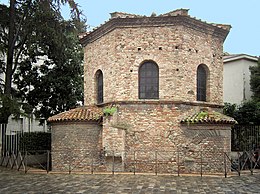Arian Baptistery
| UNESCO World Heritage Site | |
|---|---|
 Arian Baptistry ceiling mosaic | |
| Location | Ravenna, Italy |
| Part of | Early Christian Monuments of Ravenna |
| Criteria | Cultural: (i), (ii), (iii), (iv) |
| Reference | 788-006 |
| Inscription | 1996 (20th Session) |
| Area | 0.008 ha (860 sq ft) |
| Buffer zone | 0.68 ha (73,000 sq ft) |
| Coordinates | 44°25′07″N 12°12′09″E / 44.41861°N 12.20250°E |

The Arian Baptistry in
Theodoric was an
Near his palace, the king commissioned an Arian cathedral, now called the Church of Spirito Santo, but originally named Hagia Anastasis (Holy Resurrection). It was re-consecrated as the Chalcedonian cathedral of
Shape and structure
The Baptistry is octagonal in shape with some little apses and arched openings near the top. Along the external perimeter there was once a walkway that stopped at the eastern apse. Clearly, the building was once part of a larger complex. Inside are four niches and a dome with
Below, a procession of the
It took the artists several years to complete these mosaics, as can be clearly seen from the different colors of the stones used to depict the grass at the feet of the apostles. The designs are quite simple, with a gold ground, typically used in this era to infuse scenes with an ethereal glow.
Similarity to Eastern Orthodox architecture
The entire composition is remarkably similar to that of the Orthodox Baptistery of Neon. The walls are bare, but were not always so. During archaeological investigations, some 170 kilograms of tessera were found on the floor. Due to the lack of Arian references, it is believed that the artists who created the mosaics were Orthodox Christians, as the Ostrogoths were predominantly goldsmiths and not mosaic artists.
In 565, after the condemnation of the Arian sect, this small octagonal brick structure was converted into a Chalcedonian oratory named Santa Maria. Eastern-Rite monks added a monastery during the period of the Exarchate of Ravenna and further dedicated the structure to Saint Maria in Cosmedin. Around the year 1700, the structure passed into private hands, and in 1914 it was acquired by the Italian government. The Allied bombardment of World War II helped clear away other structures which had encroached on it from all sides, enabling researchers to view the details of its exterior for the first time. As with other monuments in Ravenna, the original floor is now some 2.3 meters underground.
Notability
The Baptistry is one of the eight structures in Ravenna registered as
See also
Notes
- ^ [1] Archived May 6, 2006, at the Wayback Machine


